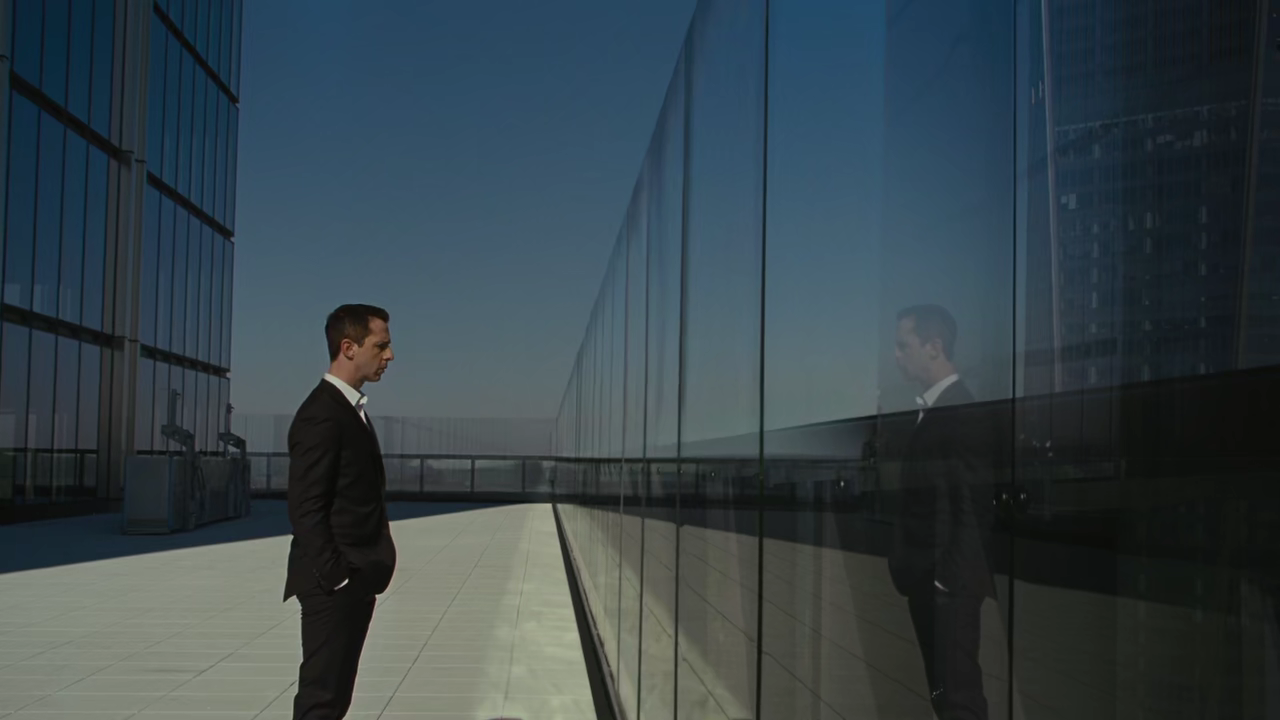In “Celebration,” the pilot episode of HBO’s Succession, the show establishes its cinematographic approach during a birthday party for Logan, the patriarch of the Roy family. Seated around the table at his beautiful Upper East Side home during a bright afternoon, the family converses amongst each other as the viewer learns the dynamics of the show’s characters.
Image via TV Moments (Tumblr).
Shot on 35mm film with direction from Adam McKay (The Big Short, Vice) and cinematography from Andrij Parekh (Half Nelson, Blue Valentine), the visual language of the pilot immediately feels different than the look of other high-end television. McKay explains to the Hollywood Reporter the setup for the table scene: “I gave everyone their own conversations they were going to have and I just did the dolly track around the table, and we just circled the table for a full [film] mag and did it three times in a row, and they were incredible…[It was] entirely improvised.” McKay notes that he initially faced actor resistance to the improvisational style, but they came to love it—“I would just say, ‘We’re rolling. You might as well,’ and then they would start to do it, and of course, they would fall in love with it. I mean, every actor does.”
Viewers may be familiar with this style from McKay’s other work, but Succession’s cinematographers are major collaborators with McKay in achieving its photographic style. Andrij Parekh shot the pilot and the next two episodes before becoming a regular director on the show. Patrick Capone, Christopher Norr, and Katelin Arizmendi have since added their own cinematography contributions. Succession colorist Sam Daley, in an interview with Digital Cinema Report, opines that the show’s “camera style is iconic…You’re a fly on the wall watching the Roy family scheme with and against each other. But there are Shakespearean moments as well, so the look of the show is rooted in both realism and classicism.”
Speaking to Kodak, Andrij Parekh talks about the nuanced convergence of the creative choices to achieve Succession’s look, such as shooting on film and lens focal length. He says, “Adam and I both wanted the same sort of filmic energy and texture to our image, although I also wanted to push the overall look towards longer lenses to create a more elegant, controlled photo journalistic perspective on the action, while also using zooms and crash zooms as emotional exclamation points to the story[.]” The viewer senses that the multiple cameras are always rolling and ready to capture the moments, alive in the spaces with the characters. Parekh adds, “[e]ffectively, this approach created an environment in which the actors never knew where the camera was…It was ostensibly filmed theatre[.]” With a consistent group of talented camera operators, the camera becomes a character itself, as Thomas Flight illustrates in a YouTube video essay, The Character in ‘Succession’ That You Never See.
This camera style has a threefold effect: it is observational, reactive, and subtly comedic, while celluloid film gives the show a textured palette to build upon. Parekh captures this interplay perfectly and how it derives from the source material. He elucidates to Kodak, “[t]he original script was very strong with lots of dry, biting humor to complement the tragedy of the Shakespearean-style storyline…[t]here’s a unique, organic soulfulness to film, which on this production, paid dividends in helping to visually support the tightrope between the comedy and tragedy of an epic human story.”
Additionally, film lends to “a special visual platform that is markedly different—dirtier, with more texture and feeling—than most audiences have been used to with modern digital-originated shows.” Patrick Capone notes that “the texture of the filmed image is so complimentary to the overall series look, especially on the actors’ faces.” Thus, with an inherent visual uniqueness, practical and naturalistic lighting would both complement and add to the show’s look, perhaps needing less fine-tuning, as film renders skin tones, colors, and shadows with pleasing characteristics. Film too “demands a stricter more organized way of working,” adds Parek. The documentary style and shooting format allows for fast, steady work and shorter days, says Capone.
Cinematographer Katelin Arizmendi, who joined the series for multiple episodes in the fourth season, provides great insights into the show’s approach on a recent episode of The Wandering DP podcast. Arizmendi discusses: “I was used to shooting things that are much more controlled…not as much handheld, stricter compositions…[On Succession], you don’t give the actors any restrictions…you strip away your ego as a DP and let them take the forefront and give them the freedom.. and light the space so that they can move around. [After blocking the scene], you figure out to light it…how to still have contrast and style[.]” Further, “the [camera] operators…are phenomenal. They're instincts with the framing and the way that they move…there’s such a naturalism to the camera work…that it doesn’t feel contrived.”
‘Half Nelson’ (2006). Cinematography by Anderij Parekh. Image via Pinterest.
Cinematographer Andrij Parekh cemented his craft with independent feature films in the mid 2000s, such as Half Nelson, Cold Souls, Sugar, and Blue Valentine. Before I knew much about cinematography, I recall watching Sugar (2008), about an aspiring baseball player, and finding its style authentic and immersive. Conversing with Craft Truck, Parekh explains that he prefers a minimalistic, naturalistic lighting style that uses available light or unobtrusive added sources. He says that “my job, I feel, is to not get in the way of the performance…to create an environment and mood for them, which I think is appropriate to the story…and let them play within that.” He adds, “people go to see movies for great performances, not nice photography, I think.” As someone who often does look for painterly cinematography in what I watch, this concept is a healthy challenge to my preconceptions. While visually appealing, Succession reminds me that story and characters are of principal importance for viewer’s connecting to the medium. The photographic results on Succession are indeed noteworthy and splendid, even if not the main focus.
Succession demonstrates that considered decisions can yield a fruitful realization of creative intentions as well as spontaneous artistic effects. The show blends writing, acting, editing, direction, sound, and cinematography with great success to create an on-screen language that has connected with audiences. “What I hope I’m part of is a movement toward naturalism…toward simplicity,” says Andrij Parekh in a video with the IFC. As Succession demonstrates, there is clear beauty and resonance in that approach.
- GJF



